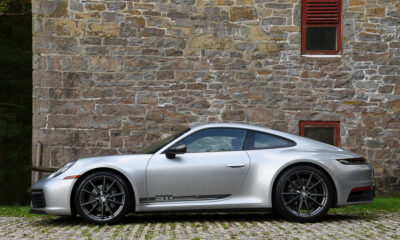
Photo: David Haueter
McLaren has built quite a reputation in a relatively short time. Aside from the McLaren F1, which had a very limited production run in the 1990s, the company has only been consistently building and selling road cars since 2011 when the MP4-12C was introduced.
Of course, McLaren already had the pedigree of decades of motorsport experience on their side, but it’s impressive, nonetheless.
Most McLaren models are hardcore sports cars that prioritize performance over comfort, but the company sought to go a bit more in the other direction with the GT model.
Based on the 720S, the GT is positioned as a more luxurious, more comfortable model that can be driven in more situations than models like the 720S, the 765LT or the Artura.
At around $210,000, the GT is also the most accessible McLaren when it comes to price.
With some design cues taken from the ultra-rare Speedtail, the mid-engined GT is a bit more elegant and understated than the Supercar models, but it’s still aggressive as well, with large side air intakes, big brakes and fat exhaust pipes.
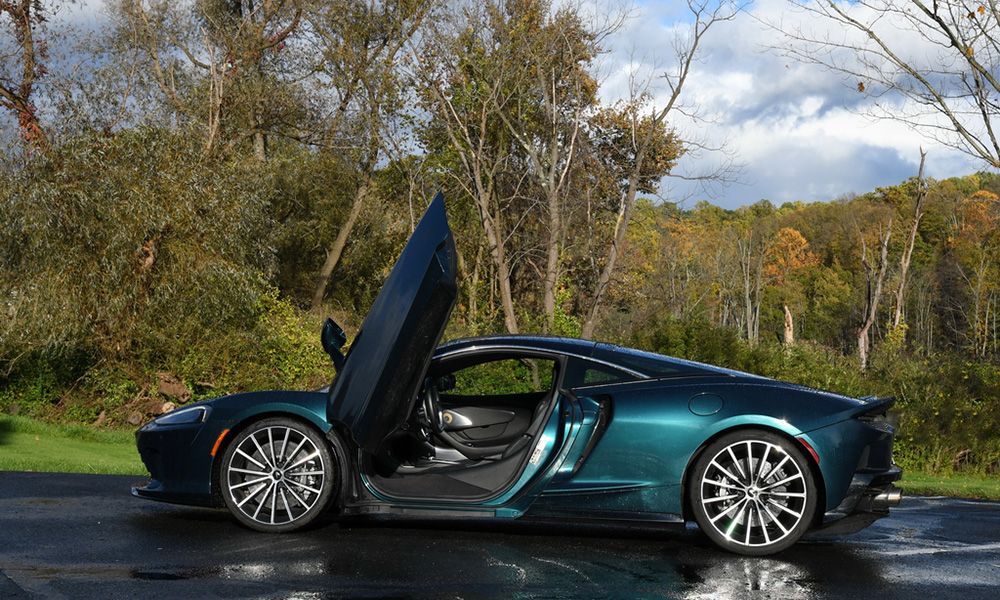
Photo: David Haueter
The 4.0-liter twin-turbocharged V8 is the same unit from the 720S model but is detuned to 612 hp (from 710 hp in the 720S) and 465 lb.-ft. of torque, with smaller yet more responsive low-inertia turbochargers.
The spec sheet of the GT certainly reads like a supercar. The GT is built around a lightweight carbon fiber chassis, has a dry sump oiling system, a 7-speed dual-clutch transmission and a double-wishbone suspension setup with adaptive damping with proactive damping control.
It tips the scales at just 3,373 pounds, which is 234 pounds more than the 720S, but its 262 pounds lighter than the Porsche 911 Turbo. The GT can rev to 8,500 rpm and hit 0-60 mph in 3.1 seconds on the way to a top speed of 203 mph.
The most obvious difference between the GT and the more hardcore McLaren models is inside. There’s leather upholstery and trim everywhere, and the engine is hidden underneath a leather-trimmed rear luggage compartment (fabric trim is also available) that has added space for cargo.
There’s more cushioning on the armrest and center console, and the carpet is more luxurious. McLaren says there’s 20 cubic feet of cargo capacity (15 cubic feet in the rear and 5 cubic feet in the front trunk).
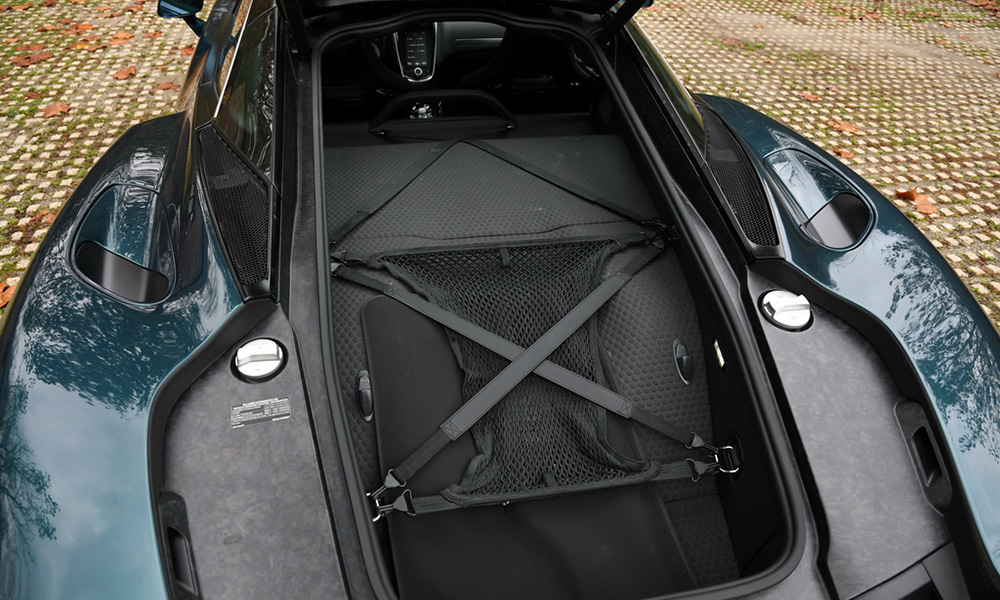
Photo: David Haueter
With nothing above it but glass, it’s probably best not to put anything in the rear luggage compartment that you don’t want to get hot, especially with the V8 right underneath it.
Another cool option in the GT that was on our test car is the panoramic glass roof that is available with an electrochromatic feature that has five different levels of transparency through the glass that can be changed by pushing buttons on the headliner. It’s an elegant way to fine-tune the amount of natural light that comes into the cabin.
McLaren made changes to the hardware as well to give the GT its own persona. Aside from the detuned engine, the transmission is tuned to deliver more relaxed gear changes, the springs are longer and softer to smooth out the ride more and the dampers are tuned to be more compliant. The exhaust is also tuned to be easier on the ears.
You still get that race car feel when you climb into the GT, as the carbon fiber tub design still makes it more of a challenge to get in and out of than a typical car.
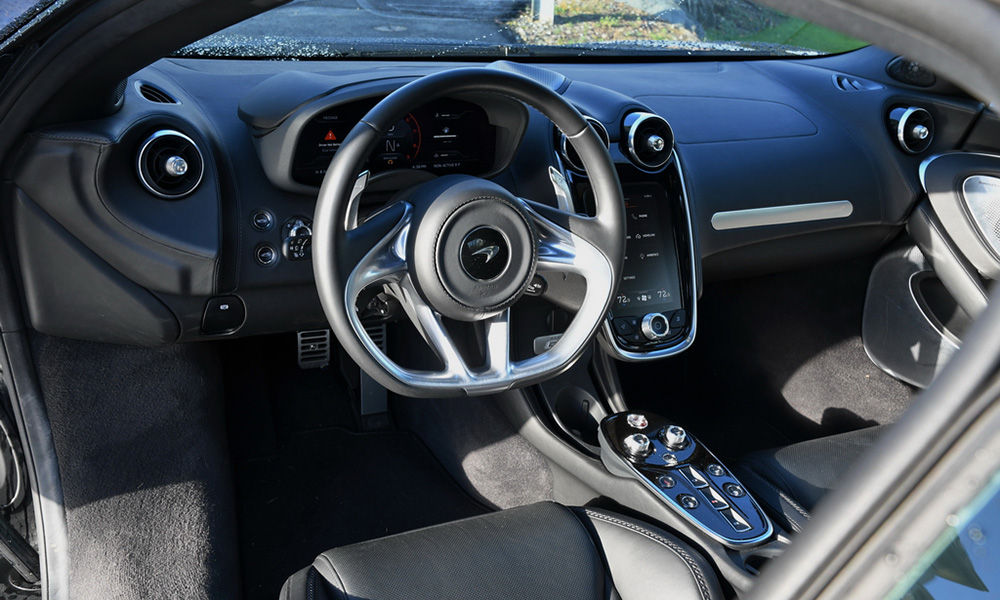
Photo: David Haueter
Getting in requires swinging your legs in over the wide sill and the bulkhead, but once you’re settled in the car has a good seating position and ergonomics. I’m 6’5” and was comfortable with enough leg and head room.
Controls in the cabin are minimal, with most of the settings controlled through a touchscreen infotainment display. The system isn’t the easiest that I’ve used but its fine once you get used to it, and the buttons and dials for the transmission and driving modes are easy to understand.
I also like the fact that the steering wheel is not littered with buttons but is used only for steering the car.
It may have a bit of a softer edge, but the GT still feels more like a supercar than other GT cars like the BMW M8 and the Mercedes AMG GT.
The engine in the GT doesn’t feel as high-strung and urgent as other McLarens, but there’s still plenty of thrust there after some minor turbo lag and it still sounds like a pure sports car, even in the comfort driving mode that’s a bit tamer. With its short hood and the engine behind you along with its low ride height, you feel very connected to the road.

Photo: Bill Dermody
The handling is the greatest strength of the GT when it comes to performance features. McLaren has made it more compliant and comfortable for daily driving, but it still feels like a supercar when you get it on a twisty road and drive it harder.
It feels poised and precise on challenging roads, with no understeer, minimal body roll, and great feedback through the steering wheel and the seat. It feels special.
Driving the McLaren GT is a bit of a different experience than driving the more focused models, but it’s not that much different. Some potential buyers may wish it were a little more comfortable and quieter, but I think McLaren did a perfect job of making it more approachable while retaining its performance.
It’s the GT car to have for those who really want a supercar but need something just a bit more usable in daily driving situations, and it retains enough of the sporting aspects that McLaren is famous for to still put a tingle up your spine when you drive it.
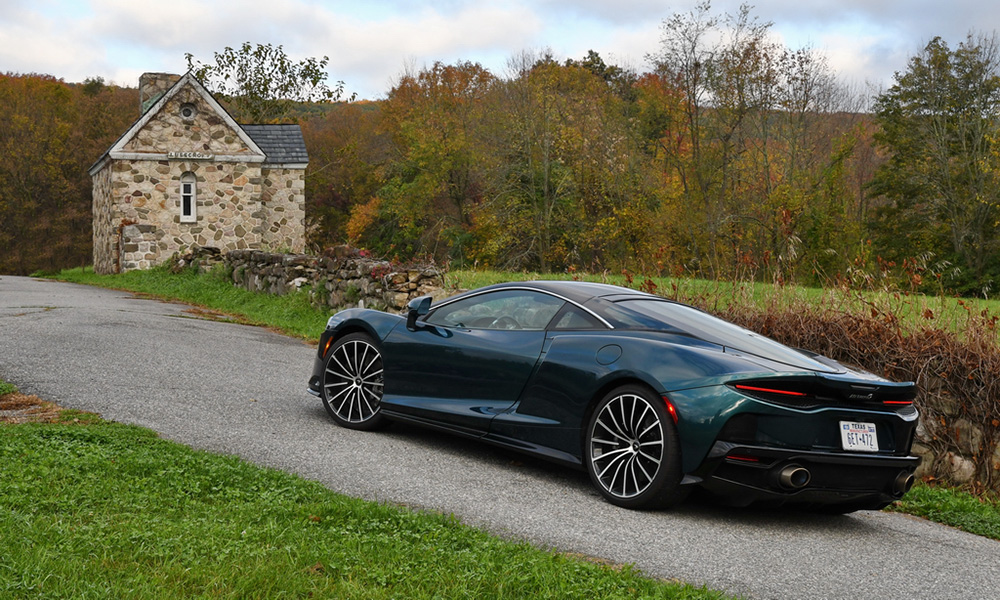
Photo: David Haueter



















